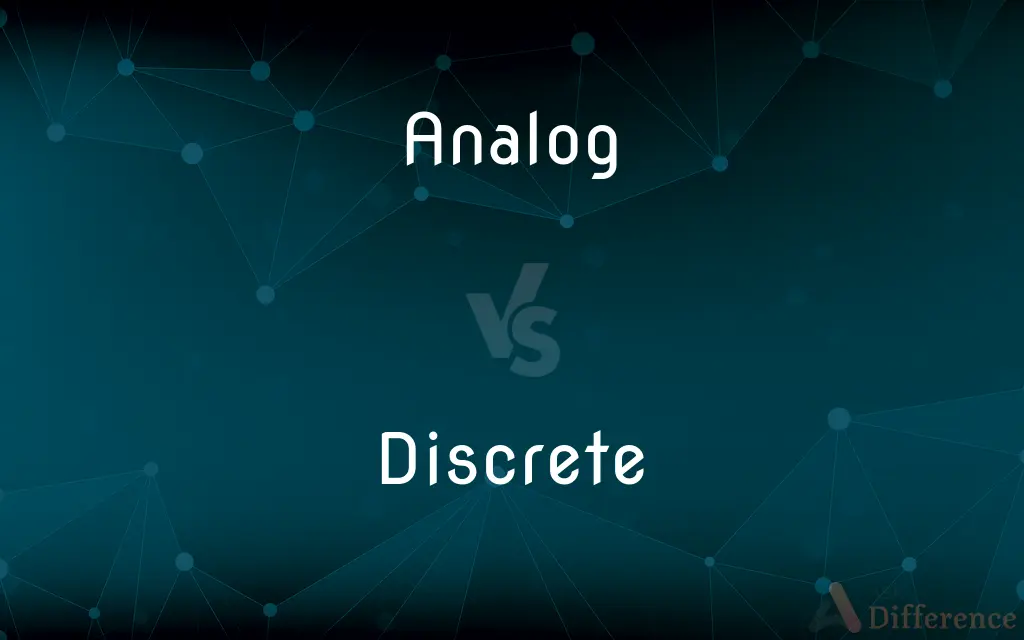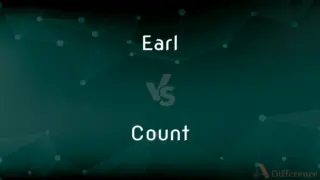Analog vs. Discrete — What's the Difference?
Edited by Tayyaba Rehman — By Fiza Rafique — Updated on April 4, 2024
Analog signals represent data through continuous flows, allowing infinite variations, while discrete signals use distinct and separate values, often digital, with a finite set of states.

Difference Between Analog and Discrete
Table of Contents
ADVERTISEMENT
Key Differences
Analog signals are characterized by their continuous nature, representing information through varying waveforms that can assume an infinite number of values within a range. This allows for a smooth and detailed representation of data, such as sound or light, closely mimicking natural phenomena. On the other hand, discrete signals, particularly digital signals, represent information using a series of distinct and separate values, typically in binary form (0s and 1s). This results in a step-like representation of data, which, while not as smooth as analog, facilitates easier processing, storage, and transmission in digital systems.
The primary advantage of analog signals is their ability to deliver a more natural and detailed representation of real-world data. This is particularly important in applications like audio and video broadcasting, where nuances and gradations in sound and images are crucial. Conversely, discrete signals' advantage lies in their robustness against noise and interference, making them more reliable in digital communications and computing environments. Digital signals can also be compressed and encrypted more efficiently, enhancing data transmission efficiency and security.
Analog signals, due to their continuous nature, are more susceptible to degradation from noise and interference, which can introduce errors in signal transmission and processing. In contrast, discrete signals, with their finite states, can be easily regenerated at intermediate points in a transmission path to maintain signal integrity, effectively mitigating the effects of noise and distortion.
The representation and processing of analog signals require analog devices, such as amplifiers and filters, that operate on continuous voltage or current variations. Discrete signal processing, however, is performed by digital devices, such as computers and digital signal processors, which manipulate data in binary form. This fundamental difference dictates the design and operation of electronic circuits and systems tailored to either analog or digital technologies.
The conversion between analog and discrete signals is a common requirement in various technological applications, bridging the gap between real-world phenomena and digital systems. Analog-to-digital converters (ADCs) transform continuous analog signals into discrete digital signals, enabling digital devices to process real-world information. Conversely, digital-to-analog converters (DACs) transform digital signals back into analog form, making digital information perceptible to humans or compatible with analog systems.
ADVERTISEMENT
Comparison Chart
Nature
Continuous
Distinct and separate values
Representation
Infinite variations within a range
Finite set of states (often binary)
Advantage
Detailed representation of real-world data
Robustness against noise and interference
Susceptibility to Noise
More susceptible
Less susceptible
Processing Devices
Analog devices (amplifiers, filters)
Digital devices (computers, DSPs)
Applications
Audio and video broadcasting
Digital communications and computing
Signal Integrity
Can degrade due to noise and interference
Maintained through regeneration
Conversion
Requires ADC for digital processing
Requires DAC for human perception or analog systems
Compare with Definitions
Analog
Represents data in a mimicry of natural phenomena.
Analog clocks use hands moving continuously around the dial.
Discrete
Often binary, representing data in 0s and 1s.
A computer processes instructions using discrete digital signals.
Analog
Signals with continuous variation.
The volume knob on a stereo produces an analog signal.
Discrete
Finite resolution but robust against noise.
Digital CDs store music in a format that resists degradation over time.
Analog
Infinite resolution within a range.
The thermostat uses an analog signal to precisely control temperature.
Discrete
Signals with distinct and separate values.
Digital clocks display time in discrete numerical increments.
Analog
Susceptible to noise and interference.
Analog television signals can show fuzziness due to interference.
Discrete
Facilitates data compression and encryption.
Streaming services use discrete signals to efficiently deliver video content.
Analog
Requires analog devices for processing.
An analog amplifier boosts the audio signal without converting it.
Discrete
Processed by digital devices.
Smartphones use digital processors to handle complex computations.
Analog
Something that bears an analogy to something else; something that is comparable
“Titan, Saturn's giant moon … seems like an analog of the environment of Earth on the eve of life” (David Grindspoon).
Discrete
Constituting a separate thing
Computers treat time as a series of discrete moments rather than a continuous flow.
Analog
(Biology) An organ or structure that is similar in function to one in another kind of organism but is of dissimilar evolutionary origin.
Discrete
Consisting of unconnected distinct parts
Society viewed as a discrete whole of individual agents.
Analog
(Chemistry) A structural derivative of a parent compound that often differs from it by a single element.
Discrete
(Mathematics) Defined for a finite or countable set of values; not continuous.
Analog
Of, relating to, or being a device in which data or a signal is represented by continuously variable, measurable, physical quantities, such as length, width, voltage, or pressure.
Discrete
Separate; distinct; individual; non-continuous.
A government with three discrete divisions
Analog
Done, happening, or existing in the physical world rather than on an electronic device
Analog strategy games.
Analog friendships.
Discrete
That can be perceived individually, not as connected to, or part of, something else.
Analog
(of a device or system) In which the value of a data item (such as time) is represented by a continuous(ly) variable physical quantity that can be measured (such as the shadow of a sundial).
An analog watch
Discrete
(mathematics) Consisting of or permitting only distinct values drawn from a finite, countable set.
A discrete sum
Analog
Not relating to, or pre-dating, digital technology such as computers and the Internet; relating to real life.
An analog (paper) map
Discrete
(electrical engineering) Having separate electronic components, such as individual diodes, transistors and resistors, as opposed to integrated circuitry.
Analog
(countable) Something that bears an analogy to something else.
Discrete
(audio engineering) Having separate and independent channels of audio, as opposed to multiplexed stereo or quadraphonic, or other multi-channel sound.
Analog
An organ or structure that is similar in function to one in another kind of organism but is of dissimilar evolutionary origin.
Discrete
(topology) Having each singleton subset open: said of a topological space or a topology.
Analog
(chemistry) A structural derivative of a parent compound that differs from it by only one or a few atoms or substituent groups; (usually, especially) such a molecule that retains most of the same chemical properties.
Insulin analogue
Discrete
Disjunctive; containing a disjunctive or discretive clause.
"I resign my life, but not my honour" is a discrete proposition.
Analog
Something having the property of being analogous to something else
Discrete
Separate; distinct; disjunct.
Analog
Of a circuit or device having an output that is proportional to the input;
Analogue device
Linear amplifier
Discrete
Disjunctive; containing a disjunctive or discretive clause; as, "I resign my life, but not my honor," is a discrete proposition.
Discrete
Separate; not coalescent; - said of things usually coalescent.
Discrete
To separate.
Discrete
Constituting a separate entity or part;
A government with three discrete divisions
On two distinct occasions
Common Curiosities
What are the advantages of analog signals?
Analog signals offer a detailed and natural representation of real-world data, beneficial in audio and visual applications.
Why are digital signals considered discrete?
Digital signals are considered discrete because they use a finite set of binary values (0s and 1s) to represent information.
What is an analog signal?
An analog signal represents information through a continuous flow, allowing for infinite variations within a certain range.
How do analog and discrete signals differ?
Analog signals are continuous and can represent infinite variations, whereas discrete signals are characterized by distinct and separate values.
How does noise affect analog and discrete signals differently?
Noise and interference more easily degrade analog signals, while discrete signals can resist and even eliminate noise through regeneration.
What is a discrete signal?
A discrete signal represents information using distinct and separate values, typically with a finite number of states.
What are the advantages of discrete signals?
Discrete signals are more robust against noise and interference, making them reliable for digital communication and processing.
What devices process analog signals?
Devices like amplifiers and filters, which operate on continuous variations, are used for processing analog signals.
What applications are discrete signals used for?
Discrete signals are primarily used in digital communications, computing, and any application requiring robust data transmission and processing.
Can analog signals be converted to discrete signals?
Yes, analog signals can be converted to discrete signals using analog-to-digital converters (ADCs) for digital processing.
Share Your Discovery

Previous Comparison
Earl vs. Count
Next Comparison
Interleave vs. InterweaveAuthor Spotlight
Written by
Fiza RafiqueFiza Rafique is a skilled content writer at AskDifference.com, where she meticulously refines and enhances written pieces. Drawing from her vast editorial expertise, Fiza ensures clarity, accuracy, and precision in every article. Passionate about language, she continually seeks to elevate the quality of content for readers worldwide.
Edited by
Tayyaba RehmanTayyaba Rehman is a distinguished writer, currently serving as a primary contributor to askdifference.com. As a researcher in semantics and etymology, Tayyaba's passion for the complexity of languages and their distinctions has found a perfect home on the platform. Tayyaba delves into the intricacies of language, distinguishing between commonly confused words and phrases, thereby providing clarity for readers worldwide.














































